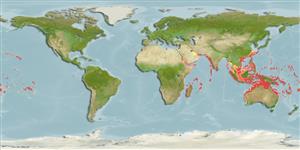Common names from other countries
Environment: milieu / climate zone / depth range / distribution range
Sinh thái học
Biển Cùng sống ở rạn san hô; Mức độ sâu 0 - 122 m (Ref. 58302), usually 4 - 46 m (Ref. 27115). Tropical; 24°C - 28°C (Ref. 27115); 29°N - 36°S, 26°E - 137°W (Ref. 57250)
Indo-Pacific: Red Sea and East Africa to the Hawaiian, Marquesas and Ducie islands, north to southern Japan, south to Lord Howe Island (Ref. 1602); exxcluding Oman and Persian Gulf (Ref. 86689). Eastern Central Pacific: Galápagos Islands.
Bộ gần gũi / Khối lượng (Trọng lượng) / Age
Maturity: Lm ? range ? - ? cm
Max length : 60.0 cm TL con đực/không giới tính; (Ref. 9808)
Các tia vây lưng cứng (tổng cộng) : 6; Các vây lưng mềm (tổng cộng) : 27 - 29; Tia cứng vây hậu môn: 2; Tia mềm vây hậu môn: 27 - 30. This species is distinguished by the following characters: body moderately deep and compressed, its depth 2.6 to 3 times in standard length (SL) (reported greatest depth of body in subadults at 2.3 in SL, Ref. 90102); dorsal profile of body uniformly convex; adults with a median, broad-based, tapering, horn-like projection extending directly anteriorly from snout at level of lower part of eye to more than 1/2 head length in front of mouth (first developing as a bump on forehead of young of about 10 cm SL; dorsal profile of snout from upper lip to base of horn very short, curved, and nearly vertical; mouth small; teeth small, spatulate, with denticulate edges, about 50 in each jaw; a continuous unnotched D VI,27-29; A II,27-30; pectoral-fin rays 15-17; pelvic fins I,3; caudal fin slightly rounded, without a filament from each corner; 2 bony plates on each side of caudal peduncle, developing moderate keels with age; colour of body olivaceous grey-brown to light grey, usually with vertical dark brown lines on body which break into small spots dorsally and ventrally; some individuals only with small dark spots; head with small dark brown spots or short irregular lines which become long and oblique on horn (dark markings on one pale phase may be faint or absent; in another phase the anterior third of the body may be distinctly paler than the rest); caudal fin whitish with a large diffuse dark blotch centrobasally in fin (Ref. 9808).
Inhabit mid-waters along steep outer lagoon and seaward reef drop-offs. Also found along rocky shores (Ref. 30573, 48637). Benthopelagic (Ref. 58302). Usually in small groups but form large schools in oceanic locations or on reefs subject to strong currents (Ref. 48637). Juveniles and subadults feed on benthic algae; adults feed on zooplankton. Pair spawning has been observed. Caught with nets (Ref. 30573). Minimum depth reported taken from Ref. 128797.
Life cycle and mating behavior
Maturities | Sự tái sinh sản | Spawnings | Egg(s) | Fecundities | Ấu trùng
Probably spawn in pairs (Ref. 240).
Myers, R.F., 1991. Micronesian reef fishes. Second Ed. Coral Graphics, Barrigada, Guam. 298 p. (Ref. 1602)
IUCN Red List Status (Ref. 130435)
CITES (Ref. 128078)
Not Evaluated
Threat to humans
Reports of ciguatera poisoning (Ref. 30298)
Human uses
Các nghề cá: Tính thương mại; Bể nuôi cá: Tính thương mại
Các công cụ
Special reports
Download XML
Các nguồn internet
Estimates based on models
Preferred temperature (Ref.
115969): 24.3 - 29, mean 27.8 (based on 1558 cells).
Phylogenetic diversity index (Ref.
82804): PD
50 = 0.5000 [Uniqueness, from 0.5 = low to 2.0 = high].
Bayesian length-weight: a=0.01950 (0.01248 - 0.03047), b=3.02 (2.89 - 3.15), in cm Total Length, based on LWR estimates for this species & Genus-body shape (Ref.
93245).
Mức dinh dưỡng (Ref.
69278): 2.2 ±0.15 se; based on food items.
Thích nghi nhanh (Ref.
120179): Trung bình, thời gian nhân đôi của chủng quần tối thiểu là 1.4 - 4.4 năm (K=0.402; Tmax=25).
Fishing Vulnerability (Ref.
59153): Low to moderate vulnerability (33 of 100).
